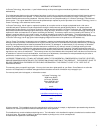
GB
P.2
GB
P.3
GB
P.4
GB
P.5
TABLE OF CONTENTS
Topic Page
Inventory of Contents 4
About WWVB 5
Quick Set-Up Guide 6
Detailed Set-Up Guide
Battery Installation 7
Program Mode
Programming Sequence 10
Function Buttons 11
Time Zone Setting 11
Time Setting 12
Date Setting 13
12/24-Hour Mode 14
DST (Daylight Saving Time) Setting 15
Features & Operations
Features 16
Radio-Controlled Time and Date 16
Projection 18
EL. Back light 19
Time Alarm 20
Changing Display Mode 22
Maintenance & Care 23
Troubleshooting 24
Specifications 25
Warranty and Contact Information 26
INVENTORY OF CONTENTS
1) WT-5350 Alarm Clock
2) AC adapter/transformer
3) Instruction manual and warranty card.
ADDITIONAL EQUIPMENT (not included)
1) Two fresh 1.5V AA batteries (optional for alarm clock)
FEATURES OF PROJECTION ALARM
1. Radio-controlled time and date
2. Projection of time
3. EL. Back light
4. Three modes of date/second display
5. Alarm
ABOUT WWVB (Radio Controlled Time)
The NIST (National Institute of Standards and Technology-Time and Frequency
Division) WWVB radio station is located in Ft. Collins, Colorado, and transmits the
exact time signal continuously throughout the United States at 60 kHz. The signal
can be received up to 2,000 miles away through the internal antenna in the Projection
alarm. However, due to the nature of the Earth's Ionosphere, reception is very limited
during daylight hours. The Projection alarm will search for a signal every night when
reception is best.
The WWVB Projection alarm receives the time data from the NIST Atomic clock in
Boulder, Colorado. A team of atomic physicists is continually measuring every second,
of every day, to an accuracy of ten billionths of a second per day. These physicists
have created an international standard, measuring a second as 9,192,631,770
vibrations of a Cesium-133 atom in a vacuum. For more detail, visit http://www.boulder.
nist.gov/timefreq.htm. To listen to the NIST time, call (303)499-7111. This number
will connect you to an automated time, announced at the top of the minute in
"Coordinated Universal Time", which is also known as Greenwich Mean Time (GMT).
This time does not follow Daylight Saving Time changes. After the top of the minute,










